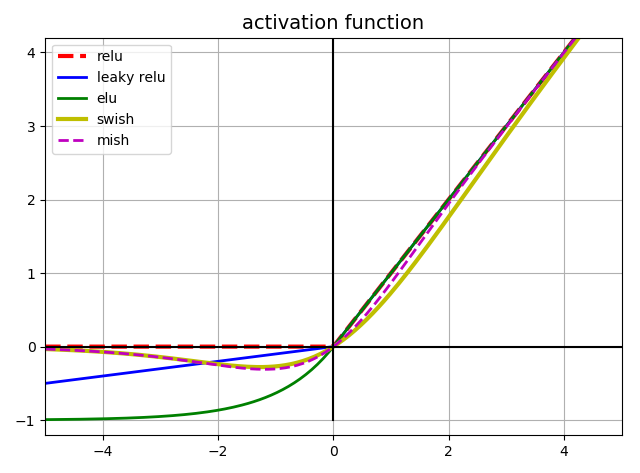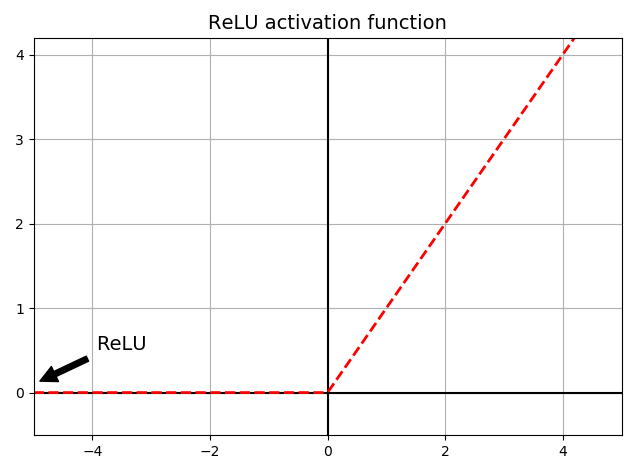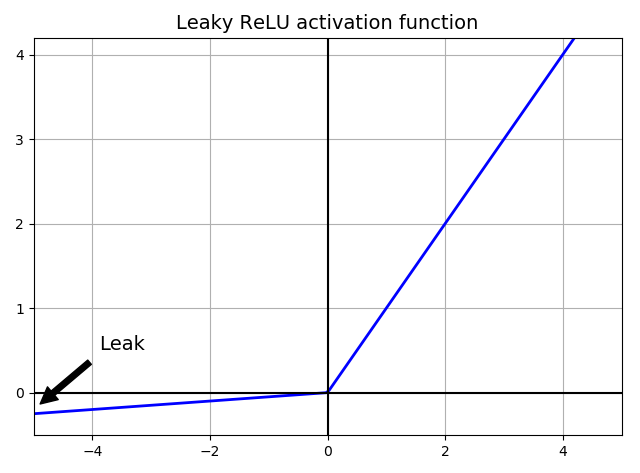TensorFlow使用记录 (五): 激活函数和初始化方式

In general ELU > leaky ReLU(and its variants) > ReLU > tanh > logistic. If you care a lot about runtime performance, then you may prefer leaky ReLUs over ELUs. If you don't want to tweak yet another hyperparameter, you may just use the default $\alpha$ value suggested earlier(0.01 for the leaky ReLU, and 1 for ELU). If you have spare time and computing power, you can use cross-validation to evaluate other activation functions, in particular RReLU if your network is overfitting, or PReLU if you have a huge training set.
ReLU
\begin{equation}
ReLU(z) = max(0, z)
\end{equation}
tf.nn.relu

import matplotlib.pyplot as plt import numpy as np def relu(z): return np.maximum(0, z) z = np.linspace(-5, 5, 200) plt.plot(z, relu(z), "r--", linewidth=2) props = dict(facecolor='black', shrink=0.1) plt.annotate('ReLU', xytext=(-3.5, 0.5), xy=(-5, 0.1), arrowprops=props, fontsize=14, ha="center") plt.title("ReLU activation function", fontsize=14) plt.plot([-5, 5], [0, 0], 'k-') plt.plot([0, 0], [-0.5, 4.2], 'k-') plt.grid(True) plt.axis([-5, 5, -0.5, 4.2]) plt.tight_layout() plt.show()

leaky ReLU
\begin{equation}
LeakyReLU_{\alpha}(z) = max(\alpha z, z)
\end{equation}
nn.leaky_relu

import matplotlib.pyplot as plt import numpy as np def leaky_relu(z, alpha=0.01): return np.maximum(alpha*z, z) z = np.linspace(-5, 5, 200) plt.plot(z, leaky_relu(z, 0.05), "b-", linewidth=2) plt.plot([-5, 5], [0, 0], 'k-') plt.plot([0, 0], [-0.5, 4.2], 'k-') plt.grid(True) props = dict(facecolor='black', shrink=0.1) plt.annotate('Leak', xytext=(-3.5, 0.5), xy=(-5, -0.2), arrowprops=props, fontsize=14, ha="center") plt.title("Leaky ReLU activation function", fontsize=14) plt.axis([-5, 5, -0.5, 4.2]) plt.tight_layout() plt.show()

ELU
\begin{equation}
\label{b}
ELU(z)=
\begin{cases}
\alpha(e^{z} - 1) & if\ z < 0 \\
z & if\ z\ge 0
\end{cases}
\end{equation}
tf.nn.elu

import matplotlib.pyplot as plt import numpy as np def elu(z, alpha=1): return np.where(z < 0, alpha * (np.exp(z) - 1), z) z = np.linspace(-5, 5, 200) plt.plot(z, elu(z), "g-", linewidth=2) plt.plot([-5, 5], [0, 0], 'k-') plt.plot([-5, 5], [-1, -1], 'k--') plt.plot([0, 0], [-2.2, 3.2], 'k-') plt.grid(True) plt.title(r"ELU activation function ($\alpha=1$)", fontsize=14) plt.axis([-5, 5, -2.2, 3.2]) plt.tight_layout() plt.show()

Relu6
\begin{equation}
ReLU6(z) = min(max(z, 0), 6)
\end{equation}
tf.nn.relu6

Swish
\begin{equation}
Swish(z) = z*sigmoid(\beta z)
\end{equation}
def swish(x, b = 1): return x * tf.nn.sigmoid(b * x)

import matplotlib.pyplot as plt import numpy as np def swish(z, b=1): return z/(1+np.exp(-b*z)) z = np.linspace(-5, 5, 200) plt.plot(z, swish(z), "g--", linewidth=2) plt.plot([-5, 5], [0, 0], 'k-') plt.plot([0, 0], [-0.5, 5.2], 'k-') plt.grid(True) plt.title(r"Swish activation function", fontsize=14) plt.axis([-5, 5, -0.5, 5.2]) plt.tight_layout() plt.show()

简单训练 MNIST
import tensorflow as tf def Swish(features): return features*tf.nn.sigmoid(features) # 1. create data from tensorflow.examples.tutorials.mnist import input_data mnist = input_data.read_data_sets('../MNIST_data', one_hot=True) X = tf.placeholder(tf.float32, shape=(None, 784), name='X') y = tf.placeholder(tf.int32, shape=(None), name='y') # 2. define network with tf.name_scope('dnn'): hidden1 = tf.layers.dense(X, 300, activation=Swish, name='hidden1') hidden2 = tf.layers.dense(hidden1, 100, activation=Swish, name='hidden2') logits = tf.layers.dense(hidden2, 10, name='output') # prob = tf.layers.dense(hidden2, 10, tf.nn.softmax, name='prob') # 3. define loss with tf.name_scope('loss'): # tf.losses.sparse_softmax_cross_entropy() label is not one_hot and dtype is int* # xentropy = tf.losses.sparse_softmax_cross_entropy(labels=tf.argmax(y, axis=1), logits=logits) # tf.nn.sparse_softmax_cross_entropy_with_logits() label is not one_hot and dtype is int* # xentropy = tf.nn.sparse_softmax_cross_entropy_with_logits(labels=tf.argmax(y, axis=1), logits=logits) # loss = tf.reduce_mean(xentropy) loss = tf.losses.softmax_cross_entropy(onehot_labels=y, logits=logits) # label is one_hot # 4. define optimizer learning_rate = 0.01 with tf.name_scope('train'): optimizer_op = tf.train.GradientDescentOptimizer(learning_rate).minimize(loss) with tf.name_scope('eval'): correct = tf.nn.in_top_k(logits, tf.argmax(y, axis=1), 1) # 目标是否在前K个预测中, label's dtype is int* accuracy = tf.reduce_mean(tf.cast(correct, tf.float32)) # 5. initialize init_op = tf.group(tf.global_variables_initializer(), tf.local_variables_initializer()) saver = tf.train.Saver() # 5. train & test n_epochs = 20 n_batches = 50 batch_size = 50 with tf.Session() as sess: sess.run(init_op) for epoch in range(n_epochs): for iteration in range(mnist.train.num_examples // batch_size): X_batch, y_batch = mnist.train.next_batch(batch_size) sess.run(optimizer_op, feed_dict={X: X_batch, y: y_batch}) acc_train = accuracy.eval(feed_dict={X: X_batch, y: y_batch}) # 最后一个 batch 的 accuracy acc_test = accuracy.eval(feed_dict={X: mnist.test.images, y: mnist.test.labels}) loss_test = loss.eval(feed_dict={X: mnist.test.images, y: mnist.test.labels}) print(epoch, "Train accuracy:", acc_train, "Test accuracy:", acc_test, "Test loss:", loss_test) save_path = saver.save(sess, "./my_model_final.ckpt") # with tf.Session() as sess: # sess.run(init_op) # saver.restore(sess, "./my_model_final.ckpt") # acc_test = accuracy.eval(feed_dict={X: mnist.test.images, y: mnist.test.labels}) # loss_test = loss.eval(feed_dict={X: mnist.test.images, y: mnist.test.labels}) # print("Test accuracy:", acc_test, ", Test loss:", loss_test) """ tf.sigmoid 0.9062 tf.tanh 0.9611 tf.relu 0.9713 tf.nn.leaky_relu 0.9674 tf.nn.elu 0.9613 Swish 0.9605 """
初始化方式
tensorflow\python\ops\init_ops.py
zeros_initializer = Zeros ones_initializer = Ones constant_initializer = Constant random_uniform_initializer = RandomUniform random_normal_initializer = RandomNormal truncated_normal_initializer = TruncatedNormal uniform_unit_scaling_initializer = UniformUnitScaling variance_scaling_initializer = VarianceScaling glorot_uniform_initializer = GlorotUniform glorot_normal_initializer = GlorotNormal orthogonal_initializer = Orthogonal identity_initializer = Identity convolutional_delta_orthogonal = ConvolutionDeltaOrthogonal convolutional_orthogonal_1d = ConvolutionOrthogonal1D convolutional_orthogonal_2d = ConvolutionOrthogonal2D convolutional_orthogonal_3d = ConvolutionOrthogonal3D
random_uniform_initializer
生成均匀分布的随机数
__init__( minval=0, maxval=None, seed=None, dtype=tf.dtypes.float32 )
random_normal_initializer
生成标准正态分布的随机数
__init__( mean=0.0, stddev=1.0, seed=None, dtype=tf.dtypes.float32 )
truncated_normal_initializer
生成截断正态分布的随机数,参数同 random_normal_initializer
uniform_unit_scaling_initializer
和均匀分布差不多,只是这个初始化方法不需要指定最小最大值,是通过计算出来的。参数为(factor=1.0, seed=None, dtype=dtypes.float32)
max_val = math.sqrt(3 / input_size) * self.factor
variance_scaling_initializer
综合体
__init__(self, scale=1.0, mode="fan_in", distribution="truncated_normal", seed=None, dtype=dtypes.float32)
scale = self.scaleif self.mode == "fan_in": scale /= max(1., fan_in) elif self.mode == "fan_out": scale /= max(1., fan_out) else: scale /= max(1., (fan_in + fan_out) / 2.) if self.distribution == "normal" or self.distribution == "truncated_normal": # constant taken from scipy.stats.truncnorm.std(a=-2, b=2, loc=0., scale=1.) stddev = math.sqrt(scale) / .87962566103423978 return random_ops.truncated_normal( shape, 0.0, stddev, dtype, seed=self.seed) elif self.distribution == "untruncated_normal": stddev = math.sqrt(scale) return random_ops.random_normal(shape, 0.0, stddev, dtype, seed=self.seed) else: limit = math.sqrt(3.0 * scale) return random_ops.random_uniform( shape, -limit, limit, dtype, seed=self.seed)
glorot_uniform_initializer & glorot_normal_initializer
标准的 Xavier 初始化方式
limit = sqrt(6 / (fan_in + fan_out))
stddev = sqrt(2 / (fan_in + fan_out))



 浙公网安备 33010602011771号
浙公网安备 33010602011771号